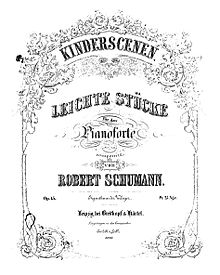Kinderszenen

Kinderszenen (German pronunciation: [ˈkɪndɐˌst͡seːnən]; original spelling Kinderscenen, "Scenes from Childhood"), Opus 15, by Robert Schumann, is a set of thirteen pieces of music for piano written in 1838. Schumann had originally written 30 movements for this work, but chose 13 for the final version.[1] Musicologist Robert Polansky has discussed the unused movements.[2]
Schumann initially intended to publish Kinderszenen together with Novelletten (Opus 21); the shared literary theme is suggested by the original title Kindergeschichten (Children's Tales). He told his wife Clara that the "thirty small, droll things", most of them less than a page in length, were inspired by her comment that he sometimes seemed "like a child". He described them in 1840 as "more cheerful, gentler, more melodic" than his earlier works.[3]
Nr. 7, Träumerei, is one of Schumann's best known pieces; it was the title of a 1944 German biographical film on Robert Schumann.[4] Träumerei is also the opening and closing musical theme in the 1947 Hollywood film Song of Love, starring Katharine Hepburn as Clara Wieck Schumann.[5]
Schumann had originally labeled this work Leichte Stücke (Easy Pieces). The section titles were only added after the completion of the music, and Schumann described the titles as "nothing more than delicate hints for execution and interpretation".[6] Timothy Taylor has discussed Schumann's choice of titles for this work in the context of the changing situation of music in 19th century culture and economics.[7]
In 1974, Eric Sams noted that there was no known complete manuscript of Kinderszenen.[8]
Movements
Notes and references
- ^ The unused movements were published years later in Bunte Blätter, Opus 99, and Albumblätter, Opus 124.
- ^ Polansky, Robert (Spring 1978). "The Rejected Kinderscenen of Robert Schumann's Opus 15". Journal of the American Musicological Society. 31 (1): 126–131. doi:10.1525/jams.1978.31.1.03a00070. JSTOR 831388.
- ^ Eric Frederick Jensen (16 January 2012). Schumann. Oxford University Press. pp. 162–. ISBN 978-0-19-983068-8.
- ^ Träumerei at IMDb
- ^ "Träumerei" played by Katharine Hepburn in the film Song of Love on YouTube
- ^ Thorpe, Day; Schumann, Robert; Von Irmer, Otto; Lampe, Walther (December 1990). "Music Reviews: Kinderszenen, Op. 15; Album für die Jugend, Op. 68 (Urtext)". Notes (2nd Ser.). 11 (4): 605–606. doi:10.2307/893060. JSTOR 837021.
- ^ Taylor, Timothy D. (December 1990). "Aesthetic and Cultural Issues in Schumann's "Kinderszenen"". International Review of the Aesthetics and Sociology of Music. 21 (2): 161–178. doi:10.2307/837021. JSTOR 837021.
- ^ Sams, Eric; Schumann; Goebels, Franzpeter (1974). "Schuman scenes". The Musical Times. 115 (1572): 146. doi:10.2307/955016. JSTOR 955016.
- ^ Original spelling: Curiose Geschichte
- ^ Original spelling: Am Camin
External links
 Media related to Kinderszenen at Wikimedia Commons
Media related to Kinderszenen at Wikimedia Commons- Free scores by Kinderszenen at the International Music Score Library Project (IMSLP)
